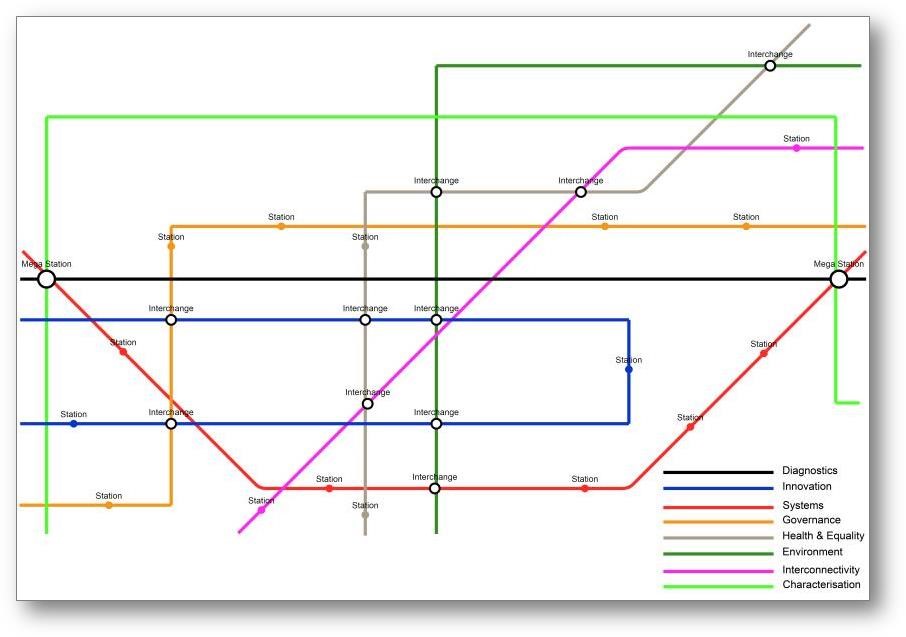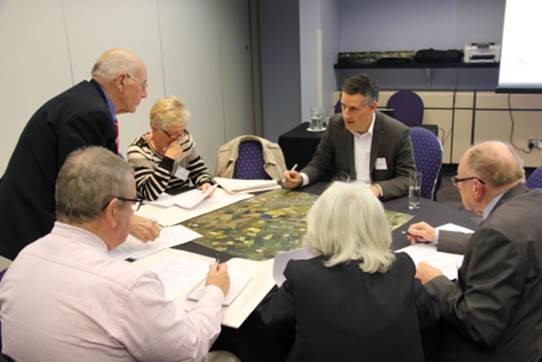 On 29 January 2019, a masterclass on urban diagnostics and reading city-regions was held in Leeds by Public Health England. Over 40 practitioners participated. This masterclass built upon the RC-UK funded Urban Living Birmingham project and was organised by Prof. John Bryson and Dr Suzanne Bartington (both University of Birmingham), Prof. Alister Scott (Northumbria University) and Chris Sharp, Workforce Development Manager, Public Health England, Yorkshire and Humber. John and Suzanne are both involved in the WM-AIR five-year NERC funded project that is applying an urban diagnostics approach to the problem of air quality in British cities and the DFID funded ASAP project that is applying urban diagnostics to three African cities.
On 29 January 2019, a masterclass on urban diagnostics and reading city-regions was held in Leeds by Public Health England. Over 40 practitioners participated. This masterclass built upon the RC-UK funded Urban Living Birmingham project and was organised by Prof. John Bryson and Dr Suzanne Bartington (both University of Birmingham), Prof. Alister Scott (Northumbria University) and Chris Sharp, Workforce Development Manager, Public Health England, Yorkshire and Humber. John and Suzanne are both involved in the WM-AIR five-year NERC funded project that is applying an urban diagnostics approach to the problem of air quality in British cities and the DFID funded ASAP project that is applying urban diagnostics to three African cities.
Urban diagnostics is a new methodological approach to identifying integrated challenges that reflect the complex interactions between socio-economic processes and place. This approach is informed by developments in medical diagnostics. Policy development and implementation in city-regions tend to be applied to problems that are defined by political debate and policy fashion rather than based on a rigorous and robust diagnostics process. Urban diagnostics provides an alternative two-stage process to inform policy development with an emphasis placed on integrated approaches to developing solutions to complex urban challenges. The first stage represents a qualitative assessment and mirrors the first stage in a process of medical diagnostics. In this stage, the experience of reading ‘patients’ leads to the identification of a preliminary diagnosis. The second stage involves quantitative testing in which data is explored and collected to test the preliminary diagnosis. This second stage applies a whole systems approach to diagnosing city-regions and must be based on an appreciation of system complexity and integration.

Reading cities as a diagnostics process should be the first stage in any policy prioritisation programme. The science and art of prioritisation is a key function of policy development; using a variety of scientific methods to identify matters that impact on city-region economies and individual health and wellbeing. The masterclass opened with an introduction and welcome by Dr Lincoln Sargeant, Director of Public Health, North Yorkshire County Council. He noted that urban diagnostics builds upon a long history in the development of public health approaches to understanding cities and health. In 1843, for example, the Royal Commission on the Health of Towns was appointed to investigate the sanitary arrangements of 50 English towns. The work of this Commission resulted in the Public Health Act of 1848.
A presentation by John Bryson on Reading-City Regions and the Art and Science of Urban Diagnostics explored the shift in approach towards reading cities and urban diagnostics. This presentation described and explored urban diagnostics and applied the approach to Birmingham. The material covered in this presentation is available in an Open Access journal paper that can be accessed here. Suzanne Bartington then discussed and reviewed urban diagnostics exploring its application to public health.

A highlight of the morning was the opportunity for delegates to play an urban diagnostics board game. Urban diagnostics include participatory approaches designed to engage with local residents and stakeholders. These approaches take many forms. One of these involves the application of approaches developed in the design of board games to diagnostics. The Urban Diagnostics board game is designed to encourage a group of players to discuss city systems and their interdependencies. The game involves three types of questions: i) questions about a single urban system, for example, transport; ii) questions that involve the interplay between two systems and iii) questions that involve the interactions between more than two urban systems. Each player takes it in turn to roll a dice and to move their counter around the board. The player then facilitates a 10 minute discussion of a question which is selected by the location of the player’s counter on the game board. Play then passes on to the next player. At the end of the game, a discussion and review is undertaken by each group of players and an overall narrative regarding city-regions is agreed. The urban diagnostics game has many advantages over a focus group. More than one game, for example, can be played in the same room and there is no need for a focus group facilitator. Players also enjoy the game element of this diagnostics process.
In the afternoon, two presentations explored examples of using data for ‘reading’ places. First, Kevin McGready, Advanced Health Improvement Specialist – Health Protection, Leeds City Council, introduced the SHAPE Atlas as an online tool to monitor health indicators. Shape is the Strategic Health Asset Planning and Evaluation (SHAPE) tool that provides a web-enabled, evidence-based application to inform and support the strategic planning of health services and assets. SHAPE links national data sets on clinical analysis, public health, primary care and demographic data with information on healthcare estates performance and facilities location. The tool includes a fully integrated Geographical Information System (GIS) mapping tool and supports travel time analysis.

Second, Peter Lowe, Strategy & Performance Improvement Manager, Doncaster, explored how data was used to shape the identification and development of Doncaster’s Inclusive Growth Priorities and strategy. The complete strategy can be downloaded here. Central to this strategy is a focus on the 3 Ps of participation, productivity and prosperity. These three Ps are captured in this strategy’s mission “To enable Doncaster people, places and businesses to enjoy improved prosperity by participating in a growing and productive economy”. It is interesting to note that there are another two Ps in this mission statement – people and place. This is important as improvements in the quality of place across Doncaster play an important role in this new strategy.
The masterclass concluded with a discussion of how to advance/enhance public health by reading cities using urban diagnostics. This included exploring the urban diagnostics approach and its transferability and application to other cities and contexts. It is worth emphasizing that central to the urban diagnostics approach to problem-solving is the identification of a range of solutions, using a system thinking approach, which values responsible inclusive growth. It is important that urban diagnostics continues to develop as a multidisciplinary tool that cuts across policy silos and continues to facilitate a more integrated or systematic approach to policy development and implementation.
This blog was written by Professor John Bryson, City-REDI, University of Birmingham.
Disclaimer:
The views expressed in this analysis post are those of the authors and not necessarily those of City-REDI or the University of Birmingham.
To sign up for our blog mailing list, please click here.
